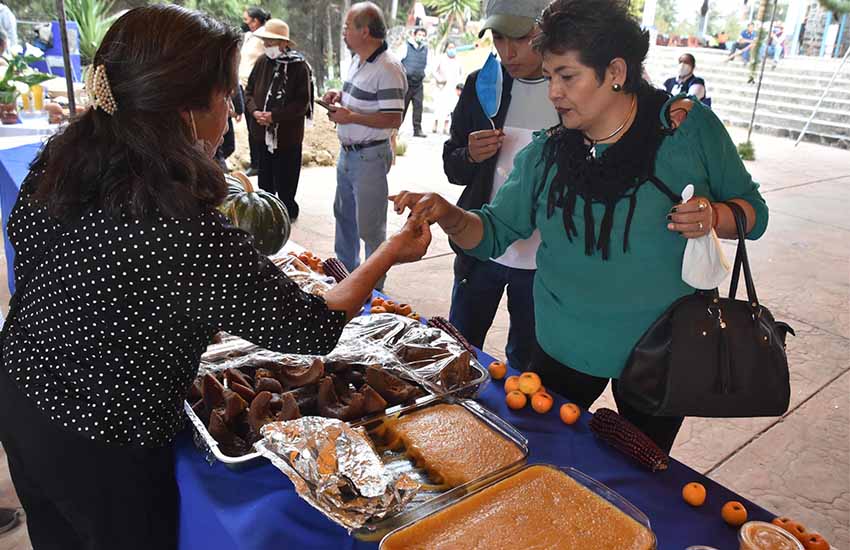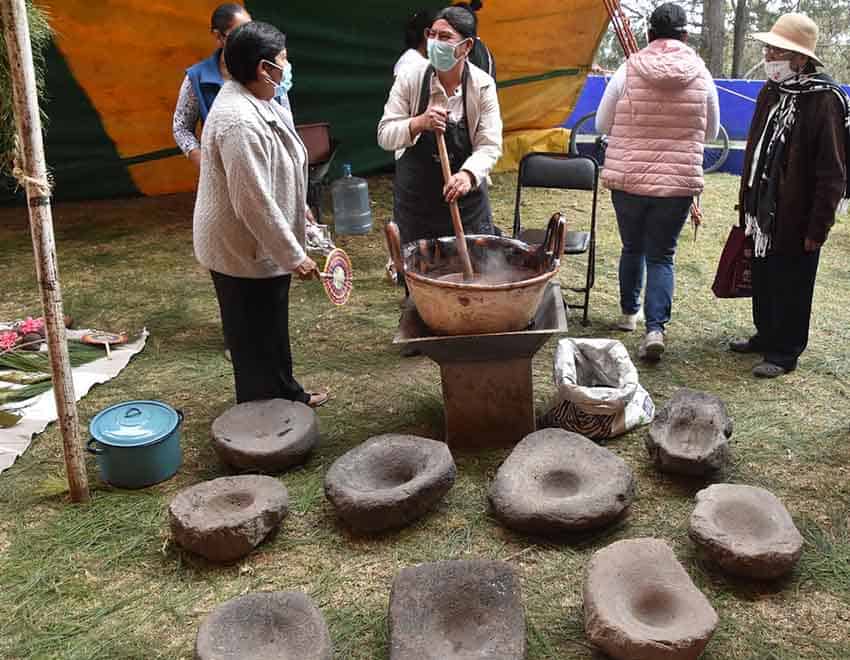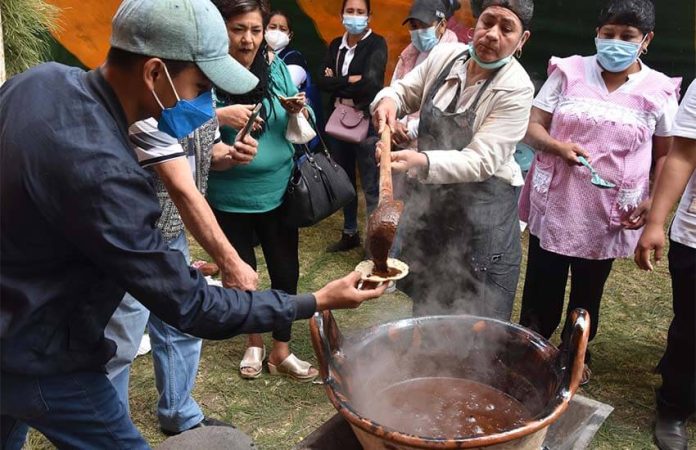San Pedro Yancuitlalpan, a tiny pueblo of 3,000 about an hour directly west of Puebla city, is starting to get some notice as a destination for people interested in authentic, ancestral foods, as evidenced by the town’s first pre-Hispanic food fair, held in mid-December.
The event was held so that visitors could learn about the region, said Ignacio Amozoqueño Ochoa, who served as the fair’s emcee.
“The idea was to promote our pre-Hispanic products, to spread and preserve our culture,” he said. “It is important that the products are primarily from here. We have a great variety, very extensive.”
Pre-Hispanic staples like tomatoes, beans, squash and chiles continue to be used daily in Mexican kitchens, but none of these defines the national cuisine — or are as integral to it — as corn. As a popular saying goes, “Sin maíz, no hay país” — without corn there is no country.
Corn was likely first domesticated in southern Mexico between 9,000 and 10,000 years ago. Although there’s still some debate about its original ancestor, it’s generally believed that it was derived from a wild grass called teosinte.

Although that may be scientifically true, indigenous Mexicans believed that corn was a gift from Quetzalcoatl, a Mexica god of, among other things, agriculture.
Apolonia Atenco Mexica stirred a large clay pot filled with what I thought was soup. She gently corrected me. “It is atole.”
Atole is made with masa — the same stuff used to make tortillas and tamales. While atole is often a sweet drink, Atenco’s atole, made with squash and peanuts, wasn’t. But it was hot and delicious and especially appreciated on a rather cool day.
The clay pot she used is the traditional way to prepare food. According to many cooks, it gives food a better flavor.
Sangre de mi Sangre (Blood of my Blood), a small company based in San Mateo Ozoclo, just a short distance away, had a table that sold food made from one thing: blue corn.
“It is a corn that many people have forgotten,” said owner Juan Hernández Jerónimo. “It is much better than white corn. We plant, harvest and make it all.”
He sells a lot of tostados (a crunchy tortilla dusted with sugar), totopos (corn chips) and churritos (small, crunchy snacks also made with corn). Pointing to the foods spread out before him on the table, he said, “From the land to here.”
I also found pulque at the fair, a mildly alcoholic drink made from agave and aguardiente, which is made from hierba amargo, an herb also used to make absinthe. One sip of that definitely warmed me up.
A short distance away, María de los Santos Martínez Pinoco stood over a comal, a traditional cooking implement, moving around the chilacayote squash seeds she was toasting. She used wood for her fire, which she said gives the food better flavor.
“We always cook with firewood; it is normal for us,” she said. “We have our own charcoal, our own wood.”
No food fair anywhere in Puebla would be complete without mole sauce, and here they had a special one made with fruits like peaches, pears and apples as well as ancho chiles, according to Leticia Corona Durán. But one ingredient made it special: chapulines (grasshoppers).
“Chapulines are a very important part,” Corona continued. “The recipe has been handed down through the generations: grandmother, great grandmother … many generations. We make it so we do not forget.”
In front of the cazuela (a large clay pot) in which her mole was simmering were several metates, a pre-Hispanic type of mortar made from volcanic rock, in this case, unearthed near the pueblo. They’re still used, as they were in ancient times, to grind corn.
Next to where Corona stirred her mole, Liliana Ivette Minero Atenco and others were making tortillas by hand. “Our grandparents made them like this,” she said.
Some people believe that tortillas made by hand taste better, but Minero wasn’t so sure. “There is not much difference in flavor,” she said. “We make them like this because it is a tradition.”
She handed me one, and when I saw that Corona was ladling her mole onto them, I stepped up for my share. I’ve avoided eating chapulines — not because I’m squeamish but because I’m a vegetarian — but mole’s one of my favorite dishes, and I figured that if I was going to write about a pre-Hispanic food fair, I had to try it.
It was really good, sweeter than other moles I’ve had, although that was certainly due to the fruits and not the chapulines.
Tejocote is a fruit that’s grown in abundance around the pueblo. Its name comes from the Náhuatl word texocotl, which has been translated as “a hard fruit with a sour taste.” Because of that fact, the fruit is usually cooked, which renders it sweet.

María Cecilia Ramos Álvarez makes a tejocote jelly that tastes a lot like peach. She also sold conservas (preserves) made from the fruit. Nearby, Columba Sánchez Popoca was selling a liquor made from tejocote.
“We boil the fruit with sugar and alcohol and then let it rest for one month,” she said. “It is better to let it age longer, like wine. The flavor changes.”
She also makes the liquor using peaches, walnuts, apples, plums and pears. “All the fruits and nuts are from this area,” she said.
Esther Cortés Rojas stirred a drink made from cacao in a pot that was sitting over a small fire. A group of 20 people or so stood in a semicircle in front of her as she explained how important cacao was in pre-Hispanic cultures. Considered by those cultures to be another gift from their gods, it was used in many religious rituals and ceremonies.
“This is a pre-Hispanic food fair,” Cortés explained, “and cacao is the most pre-Hispanic food.”
Jamie Vázquez, his wife Lucila Cuenca and his son Luis Mario Cuenca made the trip here from Puebla city because they like traditions.
“Like a good Mexican, we always want to promote our culture through events like these,” Vázquez said. “We want to promote our roots. I like the diversity of food, the pulque, conservas, cacao, all of it.”
San Pedro residents are justifiably proud of their culinary traditions. “This is the healthiest food,” said Octavio Tepetitla, who stood behind a table displaying the foods of his company, Productos Agropecuario de Teotón.
There were bags and jars of conservas, atole, and mole poblano, among other foods. “It’s semi-organic, like our grandparents [made it]. We do not use chemicals or anything. This is the way pre-Hispanic cultures ate. We want to preserve this.”
Amozoqueño, the emcee, said the pueblo planned to make the fair an annual event. “Next year, we will have it on the first days of November,” he said. “It is to spread the word about what we have here.”
The food and drink offered at this fair are only available in the pueblo, but if you’re interested in tasting them before next year, the town is small enough that everyone knows everyone and is friendly enough that people will point you in the direction of the right house.
• A couple of the businesses mentioned in this article have an online presence. Click on the links to find out more about Sangre de mi Sangre and Columba Sánchez Popoca’s tejocote liquor.
Joseph Sorrentino, a writer, photographer and author of the book San Gregorio Atlapulco: Cosmvisiones and of Stinky Island Tales: Some Stories from an Italian-American Childhood, is a regular contributor to Mexico News Daily. More examples of his photographs and links to other articles may be found at www.sorrentinophotography.com He currently lives in Chipilo, Puebla.
